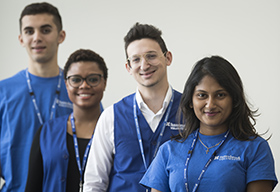New robotic surgery program transforms heart care
Dr. Derrick Tam is spearheading Sunnybrook’s new robotic mitral valve cardiac surgery program, and the first procedure at Sunnybrook took place in early April. We sat down with Dr. Tam to learn more about the impact of robotic surgery, and why it is further boosting the Schulich Heart Program’s international reputation as a centre of innovation and excellence in caring for patients with valve disease.
How does robotic mitral valve surgery work?
During the surgery, I’m seated at a console, beside the patient. From there, I control several small robotic arms that hold fine instruments to perform the operation. The console has a high-definition camera that provides a very enhanced 3D view – up to 10 times magnification – of the surgical area. A special wrist control moves the robotic instruments which are carefully placed into the patient via small one-centimetre incisions.
What are the benefits?
There are several benefits of this approach, for me as the surgeon and, more importantly, for patients:
- Small incision, and no bones are broken: Patients tend to recover faster, have shorter hospital stays, and can return to work earlier. There’s also an aesthetic benefit, as the surgical scars are very minimal.
- Excellent views of the heart: The mitral valve, one of the four heart valves that ensures blood flows in the correct direction, can be challenging to see using a traditional surgical approach where we make an incision down the middle of the chest, through the breastbone.The robotic technology has a high-definition 3D camera, allowing me to see parts of the heart that would be difficult to see with a conventional incision.
- Extremely precise: The technology eliminates something called physiologic tremor, which is a normal and slight shaking of the hands that everyone experiences when performing precise tasks. It lets me to be very precise when placing sutures.

What got you interested in robotic surgery?
While robotic surgery accounts for 10 per cent of mitral repairs in the United States, it was not being performed in the Toronto-area when I was a resident at the University of Toronto. I was very interested in learning a less invasive way to treat mitral valve disease, so went to Cedars Sinai Medical Center in Los Angeles for a fellowship specializing in robotic surgery. In a year, we did over 200 robotic mitral repairs, more than any other hospital in North America. I had brilliant and inspiring teachers that taught me everything about robotic surgery and mitral repair. I’m excited to bring my skills and expertise to help Sunnybrook patients.
What excites you about this field?
Robotic technology continues to evolve quickly. There is work being done to develop better instruments and smaller port sites, which will allow more people to become eligible for robotic heart surgery. At Sunnybrook, we will push the envelope in terms of what type of valves can be repaired. I am super excited to start this program, with a team of amazing surgeons, nurses, anesthesiologists, and perfusionists along with our partners at Cedars Sinai Medical Center. Most importantly, I look forward to training the next generation of surgeons to perform this operation so that access to robotic surgery can improve across Canada.






